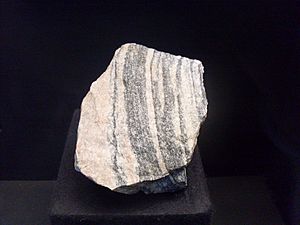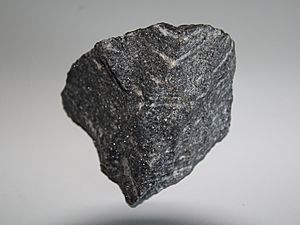Acasta Gneiss facts for kids

The Acasta Gneiss is a very old type of rock found in the Northwest Territories, Canada. It's located on an island about 300 kilometres north of Yellowknife. This rock was changed by heat and pressure (a process called metamorphosed) between 3.58 and 4.031 billion years ago. It is known as the oldest intact piece of Earth's crust that we have found.
Scientists first described the Acasta Gneiss in 1989. It was named after the nearby Acasta River, which is east of Great Bear Lake. The area where the Acasta Gneiss is found is a remote part of the land belonging to the Tłı̨chǫ people. It is the oldest known exposed rock in the world.
Contents
How Acasta Gneiss Formed
The Acasta Gneiss was originally a type of rock called a granitoid. It formed about 4.03 billion years ago. Scientists know this age by using a method called radiometric dating on tiny zircon crystals found in the rock. This method helps them figure out how old rocks are.
The Acasta Gneiss is very important for understanding the early history of Earth's crust. It formed during a very early time in Earth's history called the Hadean eon. This eon came before the Archean eon. You can learn more about these times in the Timetable of the Precambrian.
Is Acasta Gneiss the Oldest Rock?
In 2008, some scientists reported that another rock, found in the Nuvvuagittuq Greenstone Belt in Quebec, Canada, might be even older. They suggested it was 4.28 billion years old. However, the way they dated this rock was different from how Acasta Gneiss was dated.
The dating method for the Nuvvuagittuq rock did not use radiometric dating of zircon crystals. Because of this, some scientists debate if that age truly represents when the rock itself formed. It might instead be the age of older material that melted to create the rock. Rocks from the Nuvvuagittuq Greenstone Belt do show signs of being from the Hadean eon (older than 4 billion years). But the Acasta Gneiss is still considered the oldest *intact crustal fragment* with a clearly dated formation age.
Where to See Acasta Gneiss
You can see pieces of the Acasta Gneiss in different places around the world:
- In 2003, a team from the Smithsonian Institution collected a large, four-tonne boulder of Acasta Gneiss. It is now on display outside the National Museum of the American Indian in Washington, D.C.
- Another sample of the rock is displayed in the Museu de Geociências at the University of Brasília in Brazil.
- In October 2016, a piece of Acasta Gneiss was put on public display at the Clark Planetarium in Salt Lake City, Utah, USA. It is shown alongside other ancient rock samples.
- In 2006, two people named Peter Skinner and Bert Cervo gave a small piece of the rock to the Six String Nation project. Part of this rock was used in the first fret of Voyageur, a special guitar that is part of the project.
See also
 In Spanish: Gneis Acasta para niños
In Spanish: Gneis Acasta para niños


